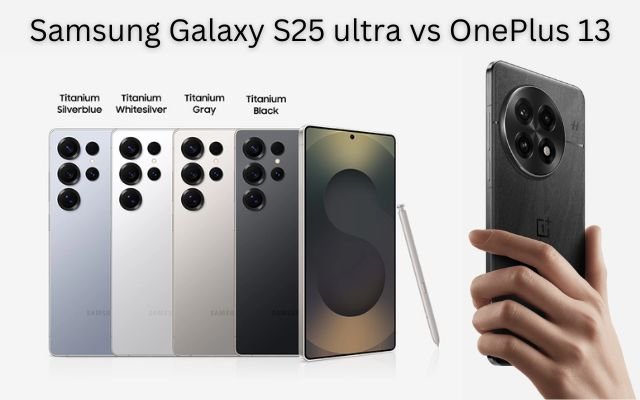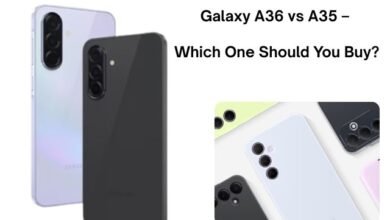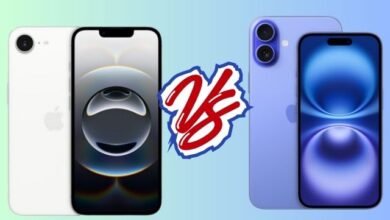Which Is Better: Samsung Galaxy S25 ultra vs OnePlus 13?
Compare the Samsung Galaxy S25 Ultra vs OnePlus 13—flagship features, cameras, battery life, and value. Which one suits you best?

January has been a big month for Android phones. The OnePlus 13 launched globally to start the year, followed by the Samsung Galaxy S25 Ultra at Galaxy Unpacked.
A Samsung Galaxy S25 Ultra vs OnePlus 13 showdown will decide the best phone to kick off the year. So, which one should you get? Here’s how they compare after the S25 Ultra’s big reveal.
Table of Contents
Galaxy S25 Ultra vs OnePlus 13: Key Differences You Need to Know
| Feature | OnePlus 13 📱 | Samsung Galaxy S25 Ultra 📱 |
|---|---|---|
| 📏 Size & Weight | Dimensions: 162.6 x 76.5 x 8.5 mm (Glass) 162.6 x 76.5 x 8.9 mm (Leather) Weight: 210g (Leather), 213g (Glass) | Dimensions: 162.8 x 77.6 x 8.2 mm Weight: 218g |
| 📺 Display | Screen: 6.82″ LTPO OLED, 1440 x 3168 pixels Refresh Rate: 1-120Hz Features: HDR10, Dolby Vision, 1,600 nits brightness (4,500 nits peak brightness), Crystal Shield glass | Screen: 6.9″ LTPO OLED, 1440 x 3120 pixels Refresh Rate: 1-120Hz Features: HDR10+, 1,600 nits brightness (4,500 nits peak brightness), Gorilla Armor 2 |
| 📱 Operating System | OS: OxygenOS 15, based on Android 15 | OS: One UI 7, based on Android 15 |
| ⚙️ Processor | Chipset: Qualcomm Snapdragon 8 Elite | Chipset: Snapdragon 8 Elite (U.S.) or Exynos 2500 (other regions) |
| 💾 RAM & Storage | RAM/Storage Options: 12GB RAM + 256GB storage 16GB RAM + 512GB storage 24GB RAM + 1TB storage | RAM/Storage Options: 12GB RAM + 256GB storage 12GB RAM + 512GB storage 12GB RAM + 1TB storage |
| 📷 Cameras | Rear Cameras: 50MP primary (f/1.6 aperture, 1/1.4-inch sensor size, OIS, Hasselblad color science) 50MP ultrawide (f/2.0, 120° field of view) 50MP periscope telephoto (f/2.6, 3x optical zoom) Front Camera: 32MP (f/2.4, fixed focus) | Rear Cameras: 200MP primary (OIS) 50MP ultrawide 10MP telephoto (3x optical zoom) 50MP periscope telephoto (5x optical zoom) Front Camera: 12MP (f/2.4, fixed focus) |
| 🎥 Video Capabilities | Rear Video: 8K@30fps, 4K@60fps, or 1080p@240fps Front Video: 4K@60fps | Rear Video: 8K@30fps, 4K@60fps Front Video: 4K@60fps or 1080p@30fps |
| 📡 Connectivity | Bluetooth: 5.4 Wi-Fi: Wi-Fi 7, dual-band 5G Support Other: BLE (Bluetooth Low Energy) | Bluetooth: 5.4 Wi-Fi: Wi-Fi 7, dual-band 5G Support Other: Samsung DeX (for desktop experience) |
| 🔌 Ports | Port: USB-C 3.2 Gen 1 (for data transfer, charging) | Port: USB-C Gen 3.2 (for data transfer, charging) |
| 💧 Water Resistance | Rating: IP69 (dust and water-resistant) | Rating: IP68 (dust and water-resistant) |
| 🔋 Battery & Charging | Battery Capacity: 6,000mAh Wired Charging: 100W SuperVOOC Wireless Charging: 50W AirVOOC Reverse Wireless Charging: 5W | Battery Capacity: 5,000mAh Wired Charging: 45W wired charging Wireless Charging: Supports wireless charging Reverse Wireless Charging: Yes |
| 🎨 Colors | Colors: White (Glass), Black (Glass), Blue (Leather) | Colors: Black, Silver, Green |
| 💰 Price | Starting Price: $900 | Starting Price: $1,300 |
Galaxy S25 Ultra vs OnePlus 13 Design and Size: Samsung Goes Slim, OnePlus Stays Durable
Samsung has refined the Galaxy S25 Ultra with a lighter titanium frame and curved corners, making it more comfortable to hold. It’s also thinner than before, but still heavier than the OnePlus 13 due to the built-in S-Pen.
The OnePlus 13 keeps its clean, modern design, featuring a durable Arctic Dawn finish that resists fingerprints and scratches. Some may not like its large circular camera module, but its IP69 rating makes it more water and dust-resistant than the IP68-rated S25 Ultra.
Here’s a quick size comparison:
📏 Galaxy S25 Ultra – 162.8 x 77.6 x 8.2 mm
📏 OnePlus 13 – 162.9 x 76.5 x 8.5 mm
While Samsung focused on a thinner, sleeker design, OnePlus built a phone that can handle extreme conditions.
Galaxy S25 Ultra vs OnePlus 13 Display Differences: Both Are Stunning
The Galaxy S25 Ultra has a 6.9-inch LTPO OLED display with a 1–120Hz refresh rate. It features Gorilla Glass Armor 2, which reduces reflections for better visibility in bright light. Samsung’s screens are known for vibrant colors, deep contrast, and top-tier HDR10+ support.
The OnePlus 13 comes with a 6.8-inch QHD OLED display, matching Samsung in refresh rate and resolution. However, its Crystal Shield glass lacks Samsung’s anti-reflective coating. Instead, it offers Eye Care 4.0 to reduce blue light and Aqua Touch 2.0 for better responsiveness with wet fingers or gloves.
Both displays are excellent, but Samsung leads in brightness and clarity, while OnePlus focuses on eye comfort and usability.
Galaxy S25 Ultra vs OnePlus 13 Display Measurements
Our display lab tests revealed that both the Samsung Galaxy S25 Ultra and OnePlus 13 offer excellent peak brightness levels. These screens remain highly visible even in bright conditions. However, the S25 Ultra has an edge due to its anti-reflective coating.
| Measurement | Samsung Galaxy S25 Ultra | OnePlus 13 | Remarks |
|---|---|---|---|
| Bright max (20% APL) | 2373 nits (Excellent) | 2326 nits (Excellent) | Both are highly bright |
| Bright max (100% APL) | 1284 nits (Excellent) | 1130 nits (Good) | S25 Ultra is brighter |
| Bright min | 0.8 nits (Excellent) | 1.8 nits (Good) | Lower is better |
| Color Temperature (K) | 6515K | 6742K | S25 Ultra is closer to ideal |
| Gamma | 1.98 | 2.3 | Slight difference |
| Delta E (RGB & CMY) | 2.84 (Good) | 1.64 (Excellent) | Lower is better |
| Delta E (Grayscale) | 5.56 (Average) | 3.95 (Good) | OnePlus 13 is more accurate |
Both phones have excellent brightness and color accuracy, but the S25 Ultra wins with its higher peak brightness and anti-reflective coating, making it the better choice for outdoor visibility.
Galaxy S25 Ultra vs OnePlus 13 Performance and Software
Both the Samsung Galaxy S25 Ultra and OnePlus 13 use the Snapdragon 8 Elite chipset. The S25 Ultra has a slightly faster version, but its software limits performance under heavy use. The OnePlus 13 does not have this issue.
For memory, the OnePlus 13 offers up to 16GB RAM, while the S25 Ultra has a maximum of 12GB.
Performance Benchmarks
| Test | S25 Ultra | OnePlus 13 | Better Performer |
|---|---|---|---|
| Geekbench 6 (Single) | 3137 | 2967 | S25 Ultra |
| Geekbench 6 (Multi) | 9769 | 9081 | S25 Ultra |
| 3DMark Extreme (High) | 6208 | 6330 | OnePlus 13 |
| 3DMark Extreme (Low) | 2981 | 3452 | OnePlus 13 |
The S25 Ultra wins in CPU power, but OnePlus 13 performs better in long gaming sessions due to better cooling.
Software & Updates
- S25 Ultra (One UI 7): Customizable and feature-rich, with 7 years of updates.
- OnePlus 13 (OxygenOS 15): Fast and simple, with 4 years of Android updates and 6 years of security patches.
AI Features
| Feature | S25 Ultra | OnePlus 13 |
|---|---|---|
| Circle to Search | ✅ Yes | ✅ Yes |
| AI Notes | ❌ No | ✅ Yes |
| AI Reply | ❌ No | ✅ Yes |
| Pass Scan | ❌ No | ✅ Yes |
| Cross-App Actions | ✅ Yes | ❌ No |
The S25 Ultra focuses on deep customization, while the OnePlus 13 offers smoother multitasking and more AI tools.
Galaxy S25 Ultra vs OnePlus 13 Camera
Galaxy S25 Ultra has a 200 MP main camera, a new 50 MP ultra-wide camera, and two telephoto lenses with 3X and 5X zoom. It delivers better colors, handles HDR well, and captures more details in low-light conditions.
The OnePlus 13 features a 50 MP main camera, 50 MP ultra-wide, and a 50 MP telephoto lens with 3X zoom. While the photos are sharp, they can look overprocessed, with boosted contrast and vivid colors. It performs well in low light, but the results are brighter than natural.
When it comes to zoom, the S25 Ultra is better with its 5X zoom and wider ultra-wide shots. The OnePlus 13 is decent at 3X zoom, but its 120X digital zoom relies on AI and doesn’t match the quality of true optical zoom.
Both phones take great selfies. For video, the S25 Ultra has warmer tones and better color accuracy, especially at night. The OnePlus 13 is better at brightening low-light videos and has solid stabilization.
S25 Ultra is superior in zoom, color accuracy, and low-light photography. The OnePlus 13 offers sharp images but tends to process them more heavily.
Galaxy S25 Ultra vs OnePlus 13 Battery Life and Charging
Galaxy S25 Ultra has a 5,000 mAh battery, while the OnePlus 13 comes with a 6,000 mAh battery. Both use the Snapdragon 8 Elite chip for efficiency. OnePlus also features Silicon NanoStack tech, which helps improve long-term battery health.
When it comes to charging speed, OnePlus is the clear winner. It supports 80W wired and 50W wireless charging, compared to the S25 Ultra’s 45W wired and 15W wireless charging.
Despite having a smaller battery, the S25 Ultra lasted slightly longer in tests. However, the OnePlus 13 charges much faster, making it a better option for those who need quick top-ups.
- Which Is Better: Samsung Galaxy S25 vs OnePlus 13?
- Samsung Galaxy S22 Ultra vs Samsung Galaxy S23 Ultra Specs Comparison
- Samsung Galaxy S25 Ultra Review
- OnePlus 13 review: The Best OnePlus Yet?
Pros and Cons of Galaxy S25 Ultra vs OnePlus 13
| Feature | Samsung Galaxy S25 Ultra 📱 | OnePlus 13 📱 |
|---|---|---|
| ✅ Pros | 🚀 Fast Snapdragon 8 Elite for Galaxy 📺 Big 6.9-inch screen with new design 🤖 Smart AI features 📱 Latest One UI 7 (Android 15) | 🚀 Powerful Snapdragon 8 Elite 🎨 Sleek design with a flat 6.82-inch screen 📷 Improved Sony camera sensor 💰 More affordable (~$900) |
| ❌ Cons | ✍️ S Pen loses Bluetooth ⚡ No Qi2 wireless charging 💰 Expensive | 🔍 Only 3x zoom ✍️ No stylus support 🤖 Fewer AI features 🚫 Not sold by U.S. carriers |
Conclusion
The OnePlus 13 offers great value with fast charging, a high-quality display, and improved cameras at a competitive price. It’s a solid choice for those who want premium features without overspending.
The Galaxy S25 Ultra stands out with better camera performance, S-Pen support, and Gorilla Glass Armor 2 for extra durability. It also has stronger software support over time.
For most users, the OnePlus 13 is the better deal, unless you specifically need the extra features of the S25 Ultra to justify the higher price.



